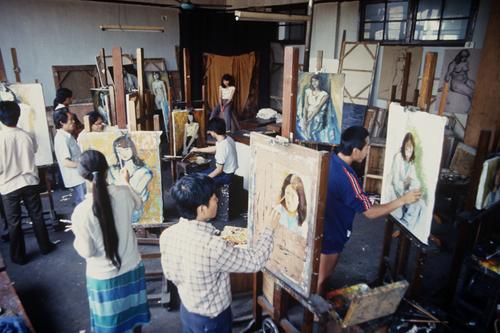About CHINACADEMY
Oil Painting Department, Zhejiang Academy of Fine Arts (now China Academy of Art), mid-1980s. Photo: Zheng Shengtian.
Tracing the transnational connections to Japan, France, the Soviet Union, and other regions, CHINACADEMY shows how institutional structures and artistic practices were adapted to the requirements of Chinese society in acts of cultural translation. It questions existing narratives of modernization, conservation, and political influence in art by highlighting personal affiliations, the agency of institutions, issues of conflict, and gendered experiences. These will be excavated through oral histories as well as archival records. By stressing the importance of academic and traditionalist practices, CHINACADEMY also decentres the paradigm of modernism that is still prevalent in global histories of modern art. It thereby proposes a new perspective for a global art history that pushes beyond Eurocentric as well as Sinocentric narratives.
Three academies will serve as case studies: The Central Academy of Fine Arts (Zhongyang meishu xueyuan, CAFA) in Beijing, the China Academy of Art (Zhongguo meishu xueyuan, CAA) in Hangzhou, and the Guangzhou Academy of Fine Arts (Guangzhou meishu xueyuan) in Guangzhou. CAFA and CAA, are the two leading institutions in Chinese art education. CHINACADEMY will take the Guangzhou Academy of Art as a case study for the work of art academies with a regional outreach and the relations between provincial centres and the cultural metropoles within China. All three academies are shaped, to varying degrees, by complex global connections, most importantly with Japan, France and other Western European countries, as well as the Soviet Union and other Eastern European nations. These entanglements also impacted conceptions of Chinese ink painting (perceived as a national art form since the early twentieth century) and its integration into the academic system. How ink painting was taught at the academies, the debates and conflicts over the question of its significance, and training methods used across different academies will be the subject of a separate case study.
